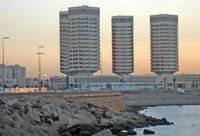
Travel and tourism, which now amounts to around 12 per cent of the country’s jobs total, is expected to rise to 15 per cent in the next 10 years, according to the World Travel and Tourism Council (WTTC). The country is now generally considered safe, if perhaps a little spartan, to travel around most of the country.
The varied scenery and pristine quality of its antiquities are fascinating; but distances are vast and facilities are quite primitive in some places. Many tour operators advise visitors to carry their own supplies of bottled water and toilet paper, for instance.
